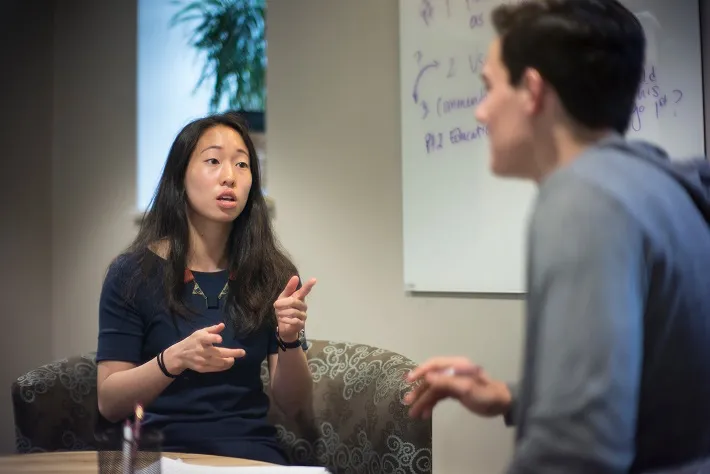- Guidelines for Faculty Using WAs with their Course
ADAPT YOUR SYLLABUS TO ALLOW FOR THE WA/SPA PROCESS.
For one-on-one conferencing, there needs to be at least 7 days between due dates. WA/SPAs should not be asked to work during the reading and finals periods. The Writing Center maintains hours during these periods for students who desire assistance with their final assignments.
MEET WITH THE WA/SPAS AT THE BEGINNING OF THE SEMESTER TO DISCUSS EXPECTATIONS FOR THEIR WORK WITH YOUR COURSE.
- Discuss assignment due dates.
- Discuss your assignments and expectations for them. Share with the WAs your goals for the assignment and if there are particular aspects of the writing or speaking process you would like the WAs to focus on. For example, do you hope your students learn how to perform a particular genre of writing, or do you hope the assignment provides a space for students to explore and apply concepts of the course?
- Discuss logistics and potential challenges.
- How will students sign up for conferences?
- What should the WA do if a student misses a conference?
- What should the WA do if they notice the student lacks understanding of course material?
INVITE WA/SPAS TO COME TO CLASS BEFORE THEY BEGIN THEIR WORK WITH YOUR STUDENTS TO INTRODUCE THEMSELVES AND THEIR GUIDELINES FOR CONFERENCING.
ASSIGN STUDENTS TO WORK WITH THE SAME WA THROUGHOUT THE SEMESTER.
The process works well when the WA and student can build a rapport with each student and learn what areas of writing the student wishes to work on in their assignments. The easiest way to do this is to assign a certain section of the alphabet to a particular WA.
COLLECT FIRST DRAFTS FROM STUDENTS AND HAVE THEM SIGN-UP FOR A CONFERENCE WITH THE WA.
Students seem to be more accountable if they are required to submit their draft to the professor. In a face-to-face setting, students can submit hard copies in class and sign up on a conference sign-up sheet provided by the WA. In an online course, create a folder on Moodle or Google where the students and WAs can access the papers and provide an electronic sign-up sheet.
Please DO NOT have students send their papers to the WA directly, unless there are special circumstances. Students sometimes take advantage of their WA's kindness and wait until the last minute to send in a draft putting the WAs in a difficult position. We want to provide flexibility when needed, but overall it helps all involved if paper submission goes through the professor or course rather than directly between the WA and student.
COLLECT BOTH THE “WA COPY” AND THE REVISED DRAFT ON THE SECOND DUE DATE.
The written comments may provide a limited view of what the WA and student discussed. Some professors have students write a note explaining what was discussed during the WA conference and the revisions the student made between the two drafts. They may also solicit questions the student still has about their paper.
MEET WITH THE WAS AFTER THE FIRST ROUND OF PAPERS TO SHARE YOUR INSIGHTS ON THE STUDENT PAPERS OR PRESENTATIONS.
- Dialogue with WAs about how students engaged with the assignment.
- Share questions or comments you have about the feedback shared by the WA.
STAY IN CONTACT WITH WAS ABOUT UPCOMING DEADLINES
- Inform students of changed or upcoming due dates.
- Make sure WAs are clear about the expectations of an assignment. These expectations can be shared in a meeting or via email. It's helpful for WAs to know what information you share with your students about a particular assignment.
PROVIDE TIME AT THE END OF THE SEMESTER FOR YOU AND YOUR STUDENTS TO EVALUATE AND PROVIDE FEEDBACK FOR THE WAS.
- At the end of the semester, we will send you a feedback form for all students to complete. To increase the response rate significantly, please take time in class to have students complete the form. It should take 10-15 minutes. The WAs use this feedback to inform their practice.
- Meet with WAs to provide feedback on what worked well and what can be improved.
- Different Models for Course WAing/SPAing
- One-on-One conferencing- WAs/SPAs work either synchronously or asynchronously with students on an assignment. They can work with students before they produce a draft or with a rough draft. With this model the professor sets two due dates for each assignment that includes the WA process. To provide WAs ample time to read and conference, there should be a minimum of 7 days between the first and second due date. For each student, WAs spend on average 30 minutes reading the paper and another 30 minutes in a conference. They need time to schedule this work around their other commitments.
- Cohort Model- A WA/SPA meets weekly or bi-weekly with a small group of students throughout the semester. These meetings might involve a write-in for students to come together to work on an assignment, office hours, one-on-one conferences, or workshopping of an assignment.
- Workshop Model- WAs/SPAs and the professor meet with a small cohort of students to workshop a first-draft of a paper. After the workshop the professor and WA share written comments with each student.
For a list of the current Course WAs and their conference locations, click here.




